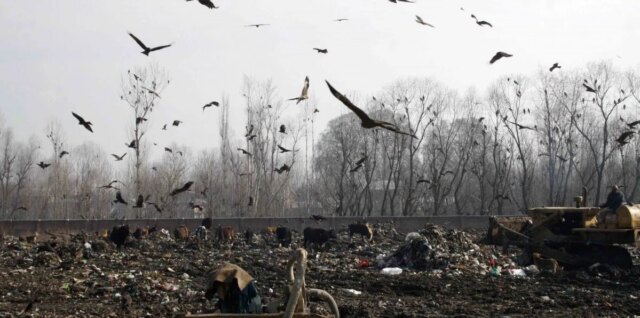Srinagar, Oct 5: The Srinagar Municipal Corporation (SMC) has said that within 30 months, the decades-old environmental hazard and public nuisance, the Achan landfill, will be transformed into a sustainable treasure trove, helping make Srinagar’s air pristine once again.
For now, the omnipresent stench from the site’s towering mounds of untreated waste continues to make life around it miserable.
In homes, schools, and streets nearby, the foul air triggers respiratory ailments, headaches, and an unrelenting sense of unease.
A local described the experience as “living in a stinky manhole.”
The Achan crisis extends far beyond residential areas.
The SKIMS Soura, once considered an ideal hub for developing medical tourism in Kashmir, has become a direct victim of the filthy air emanating from Achan.
Patients, many already battling serious illnesses, are forced to endure the daily distress of the overpowering odour.
Without immediate intervention, experts warn, the site’s toxic emissions could continue to pose a “silent killer” threat to people in the hospital and surrounding areas.
Over the years, successive authorities have only added tonnes to the problem.
However, now, the SMC says the change is in the air.
Speaking to Greater Kashmir, SMC Commissioner Faz Lul Haseeb said work on the bioremediation of municipal solid waste has already begun.
He said that the contract had been awarded to EcoStan, a Punjab-based firm specialising in the scientific treatment of legacy waste.
“We have committed to the National Green Tribunal (NGT), and it is our pledge to the people that the waste will be treated in the most scientific manner possible. A sustainable solution to this decades-old issue is finally being implemented,” Haseeb said.
He said that the project aims to process 30,000 metric tonnes of waste per month.
“The goal is to clear the site’s staggering 11 lakh metric tons of legacy waste within the next 30 months,” the SMC Commissioner said.
He acknowledged that the foul-smelling, gas-laden air from the site represented a “gross violation of people’s fundamental right to breathe fresh, healthy air.”
Haseeb said that a contour assessment would be conducted in the coming days to monitor progress and measure the rate of waste remediation.
“The contour survey will help us map the terrain and optimise operations,” he said.
Detailing the broader plan, the SMC Commissioner said the project includes a waste-to-energy component that would convert part of the refuse into usable fuel.
“Many industries can utilise the fuel extracted from the waste,” he said.
Haseeb said that recycling initiatives for recoverable materials would enhance sustainability and reduce environmental impact, while biodegradable waste would be transformed into nutrient-rich soil to support horticulture, floriculture, and agriculture.
“In addition, construction debris will be granulated for reuse in infrastructure projects,” he said.








